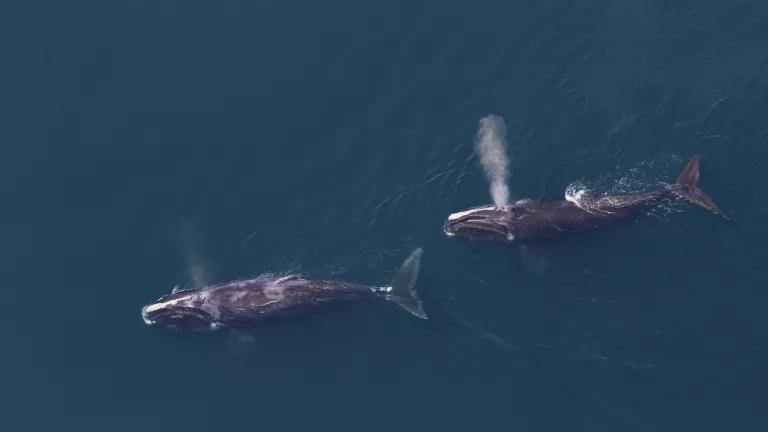Administration Aims to Protect Right Whale, Advance Wind
New strategy to protect North Atlantic right whales during offshore wind development is an important start, but needs proactive protection requirements.

The draft strategy identifies increased risks to right whales from offshore wind development noise, entanglement, vessel strikes, and habitat changes that may impact the whale’s prey; it also recommends important protections.
© NOAA Fisheries
New Strategy Document Holds Promise, But Falls Short on Action and Funding
A new federal strategy “to protect and promote the recovery of North Atlantic right whales while responsibly developing offshore wind energy” reflects both an urgent need to act now for this critically endangered species and a commitment to advance this new American industry responsibly. Still, as outlined, the strategy does not go far enough to protect right whales from underwater noise and vessel strikes. The proposed activities are also currently unfunded, raising questions about their implementation. Strategy comments are requested by December 4.
We need offshore wind, and we need to do it right. This kind of clean energy will help eliminate dangerous greenhouse gas emissions and create thousands of well-paying sustainable jobs. But as we fight climate change, we must avoid, minimize, and mitigate threats to ocean life in whatever ways we can.
Fewer than 340 North Atlantic right whales remain. Right whales are rapidly declining because of vessel strikes and fishing gear entanglements, and the species faces all sorts of other threats, including underwater noise pollution and malnourishment, all while fighting to adapt to climate change.
Scientists say that if the species is to avoid extinction, humans cannot cause even one right whale death or injury each year. With the species simply unable to withstand more loss or disturbance, the right whale crisis is not a problem caused by the offshore wind industry, but it is one the industry must face.
The Draft North Atlantic Right Whale and Offshore Wind Strategy is an important milestone in achieving the administration’s commitment to fight climate change, and to stem biodiversity loss. The strategy was developed together by the agencies that lead on offshore wind (the Bureau of Ocean Energy Management, or BOEM) and right whale conservation (the National Oceanic and Atmospheric Administration). It reflects a clear-eyed awareness of the threats offshore wind development may pose to this iconic species and the need to embrace protective measures designed to avoid conflicts with the species at all stages of wind development.
BOEM and NOAA pledge to create a group to implement the strategy: to explore and advance the outlined mitigation and decision-support tools, and research and monitoring, and to collaborate regularly with all levels of government, stakeholders, and the public.
The strategy announces work on a quieting performance standard – a maximum noise limit – for construction activities, which is an important step forward. Other nations have ocean noise caps, and BOEM’s pursuit of one tailored to protect U.S. species of concern could be a game-changer in reducing offshore wind’s overall noise footprint. Encouragingly, the agencies also note interest in integrating quieting technologies into new offshore wind vessels. BOEM should also require engineering solutions that reduce sound generated by operating turbines, which the report notes have the potential to erode the quality of important right whale habitats.
The draft strategy falls flat, however, by failing to require a slate of promising avoidance and minimization measures, or to identify funding sources for the needed rigorous regional and project-level monitoring studies. A rough “menu” of options is provided for regulators and developers, but proactive measures should be required.
Offshore wind is expected to begin large-scale installation next year off Southern New England. In the absence of requirements for stronger avoidance or minimization measures, right whales will be at an increased risk of exposure to harmful levels of underwater noise, as well as deadly vessel strikes. This region represents a vital feeding area and migratory corridor for the species. We have only a brief opportunity before steel goes into the water to layer in further necessary North Atlantic right whale protections for these projects and to shape future ones. Right whale protections that should be integrated into offshore wind development include:
- Keeping speeds for all project vessels to 10 knots or less. Even a single, accidental strike from a single vessel can jeopardize the survival of the species. Until there’s a real-time whale detection and response plan scientifically proven to meet or exceed the protections offered by traveling at 10 knots, we must slow down to accommodate the species. The administration’s proposed vessel speed rule would significantly strengthen existing requirements and meaningfully reduce risks—we need to keep this rule strong, and build on it to ensure that this new industry embraces all necessary protections.
- Noise reduction. Technologies that significantly cut down on pile driving noise should be required to avoid or minimize harmful noise levels at the outset.
The strategy notes a future need to tackle risks posed by floating offshore wind technology, including an elevated risk of entanglement given its extensive underwater infrastructure. The strategy offers some forward-thinking actions, including proactive development of entanglement risk-reduction strategies. These will require more specificity, and we must do the necessary research and development now to make sure mitigation is available at the very beginning of floating offshore wind construction.
The public has the opportunity to weigh in on the draft strategy and urge the administration to start America’s offshore wind industry off strong, with robust protections in place for the right whale. Incorporating meaningful mitigation requirements into the strategy would solidify the Biden administration’s investment in expanding this new American industry the right way.
NRDC is fighting to save the right whale from a host of threats – and to establish responsible offshore wind. Both of these goals can be achieved. We need a proactive, protective right whale and offshore wind strategy, based on the best available science and designed to learn as we go. The administration should add in the avoidance and minimization measures a strong strategy requires.




